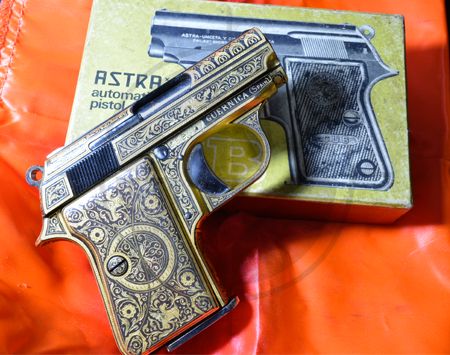PBD HCON 2018 Astra Cub DAMASCENE Pistol

Astra Model 2000 “Cub”
Along with copying the Model 1906, Spanish manufacturers made .25 caliber pistols to different designs, one of the best being Astra’s Model 2000. In 1954 Astra-Unceta y Cia, one of Spain’s premier handgun factories, replaced its Model 200 Firecat, a Model 1906 copy with the Model 2000 Cub. This incorporated an exposed hammer and eliminated a grip safety, though unusually in Spain it did include a magazine safety. Astra made over 150,000 Cubs in .25 caliber, along with many more in .22 Short and a related gun, the Model 7000, in .22LR.
These are basically compact Astra 1000s with an external hammer but without a grip safety. They come in a variety of calibers; the Astra 2000 fires .22 Short ammunition, the Astra Cub fires .25 ACP, and the Astra 7000 fires .22 Long Rifle. The Camper was the version of the Cub sold in the US; it has a 4-inch barrel but is otherwise identical to the Cub.
Colt had Unceta manufacture the Cub for them from 1957 to 1968, after which production resumed in the USA as the “Colt Junior” between 1970 and 1973. Introduced in 1951, the pistol made most of its sales to the US, and the 1968 Gun Control Act brought an end to those sales. Production stopped soon thereafter. The US factory performing this work in Accokeek, Maryland, became the nucleus of the Beretta USA plant several years afterward, and the scene of another chapter in the .25 story.
Astra Model 2000 Cub
Specification:
Caliber: .25acp
Model: Cub
Magazine capacity: 6 rounds
Trigger Mechanism: Single-action only
Barrel length: 3″
Finish: Damascene
Box includes the unit and 1 magazine only
Damascening –
The ethereal art of weapon ornamentation, also known as Koftgari, is the Arabic term for the art of decorative damascening of hard ferrous metals with hair-thin precious metal wires encrusting gold, silver or copper wire into a darkly oxidized background surface made from iron, steel, bronze or brass. A narrow undercut is made in the surface of the metal with a chisel and the wire forced into the undercut by means of a hammer. The name is derived from the city of Damascus, capital city of Syria, which was celebrated for its damascened wares as early as the 12th century. Damascus steel was the forged steel comprising the blades of swords smithed in the Near East from ingots of wootz steel. These swords are characterized by distinctive patterns of banding and mottling reminiscent of flowing water. Such blades were reputed to be tough, resistant to shattering, and capable of being honed to a sharp, resilient edge.
It may either refer to swords made or sold in Damascus directly, or it may just refer to the aspect of the typical patterns, by comparison with Damask fabrics (which are themselves named after Damascus)
This particular art of damascening is believed to have reached India during 16th century. The erstwhile Mughal invaders had brought the art with them from Persia.
Eventually, the art found patronage among the kings of Rajasthan, where it flourished like a splendid foreign art until it became an inevitable part of the state’s own culture. Sikligars, the traditional weapon makers in Rajasthan of the time, specialized the art, ameliorating their already splendid skills of weapon making. Koftgari enabled Sikligars to craft functional and gracefully ornamented weaponry for the rulers and noblemen of the time.
The process these Sikligars used to develop a koftgari decorated weapon, was quite time-consuming, laborious, as well as artistic. First of all, the base metal (usually made of hard steel) is heated. Then, its surface is scratched thoroughly and evenly in a crosshatched manner. The plate is then heated once again to make it rough and easily adaptable for the wire inlaying. Once all these laborious tasks are done, the artistic part of the process begins.
Fine metallic wires are carefully pressed into thus prepared surface. Since no prior sketching can be done on metal, the weapon maker has to decide the design or pattern of the koftgari, in real time, when he is inlaying the metallic wires. Evidently, this stage of koftgari needs a great deal of precision and quick hands, so the whole work can be completed before the steel cools down.
Once the whole design is etched, the product is heated so that both the metals can infuse properly. Then using a smoother the cross hatched surface is smoothed, and heated again for one final time to give it that lustrous appearance.
Koftgari is mostly used in the ornamentation of sword’s, daggers, or similar weaponry’s hilts. Another prominent use of the arts is found on the shields. Some rare pieces of armory (like helmets and armlets) too were found with the Koftgari embellishments.
Shop at our main store:
P.B. Dionisio & Co. Guns and Ammo Store
No. 27 Don A. Roces Avenue,
Quezon City, Metro Manila
Philippines
Contact Nos.: 922-8361 to 64 / 373-3088 / 372-2710 to 12
Fax No.: 372-2713
Store hours are Monday to Friday, 9AM to 6PM and Saturdays, 9:30AM to 3:30PM.
Email address: sales@pbdionisio.com
